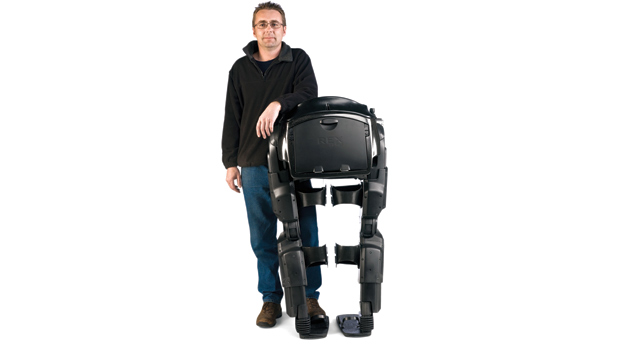The bionic legs, called Rex, were road-tested publicly for the first time Thursday by 23-year-old Hayden Allen who was told five years ago he would never walk again after being paralyzed from the chest down in a motorcycle accident.
Allen said the experience of being able to stand up and walk when strapped into his robotic legs was fantastic and he felt like a normal human being again.
“I’ll never forget what it was like to see my feet walking under me the first time I used Rex,” said Allen, who is 6’4” tall when standing. “People say to me, ‘look up when you’re walking’ but I just can’t stop staring down at my feet moving.”
Inventors Richard Little and Robert Irving, two expatriate Scottish engineers who emigrated in the early 1990s, came up with the idea seven years ago and have spent nearly $7 million developing it.
“Both of our mothers are in wheelchairs so we are aware of some of the obstacles and access issues faced by many wheelchair users,” said Little.
Little’s Multiple Sclerosis diagnosis seven years ago was the catalyst for these men to put their engineering skills to use to develop a practical, standing and walking alternative to wheel chairs.
The 38-kilogram joy-stick operated legs were inspired by the movie "Aliens" in which the character Ripley (played by actress Sigourney Weaver) climbs into a robotic exoskeleton to fight an alien.
Rex is "a realistic standing and walking alternative to wheelchairs," the inventors said on their website Rexbionics.com.
"It enables the user to climb up and down stairs, sit, stand, and step backwards, sideways and forwards — providing the opportunity for people in wheelchairs who want to walk, to do just that."
Each Rex is built onsite at the Rex Bionics’ Auckland plant. It has been designed to be practical, lightweight, portable, safe and simple to use and sufficiently powered for a typical day of use. The founders are quick to point out that Rex is not a replacement for a wheelchair, but a complement that offers a range of options not currently available anywhere else in the world. It is potentially suitable for manual wheelchair users who can self-transfer and operate hand controls.
Potential customers must complete a medical appraisal including checks with their own physician to ensure their general health and suitability before they can begin the process of fitting and training. This process typically takes around two weeks with Rex Bionics’ team of technicians, based at the Rex Center in Auckland.
However, Rex comes with a hefty price tag of $150,000 and at present is only available in New Zealand although the inventors said it would be sold worldwide from next year.
Rex Bionics, which now employs 25 mechatronic and sofware engineers, believes demand will outstrip supply for the next few years and they have already had enquiries suggesting people will pay up to $250,000.










